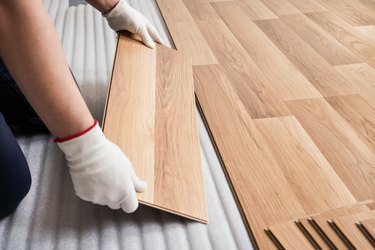
The most common causes of separation between laminate flooring planks are environmental and include changes in temperature and humidity that cause the planks to expand and shrink. The shrinking is often apparent in gaps between the ends of the planks (lateral gaps), but the gaps can also appear along the sides of the planks (longitudinal gaps). You can often prevent these by giving the flooring plenty of time to acclimate before you install it, but in homes with central heating, humidity can drop low enough to make gapping inevitable, no matter what you do.
There's another common reason for longitudinal gapping, and that's an uneven subfloor. The planks ride up on bumps in the subfloor, and the pressure the bumps put on the joints causes them to separate. This is also a problem that can be prevented by proper installation practices, but what's done is done, and if your floor is separating, you have to do something about it now.
Video of the Day
Video of the Day
How to Close Lateral Gaps
Fortunately, it's fairly easy to close lateral gaps, which are the ones you see between the ends of the planks. If you're wearing rubber-soled shoes, you may even be able to do it by kicking the planks back together. There's a tool on the market called a floor gap fixer that works according to this principle. It consists of a metal block with a sticky surface and a rubber mallet. You push the block down on the surface of one of the planks and tap it with the mallet to close the gap.
You don't need to spend the money to purchase a floor gap fixer, because any block of wood or metal will work, and so will any type of hammer. Just line one side of the block with a substance that creates plenty of friction without causing any damage, such as rubber or double-sided carpet tape, and tap it with any hammer you happen to have. If you use a hammer with a non-rubber head, make sure it doesn't contact the plank when you swing it.
Lateral Gaps on the Entire Floor
In extreme climatic conditions, such as unusual dryness or high temperatures, lateral gaps may appear along the entire length of a floor. In this case, tapping individual planks together is difficult, and you're better off tapping the end of each row to close all the gaps at once.
To do this, you need a laminate pull bar, which is a metal tool that looks like a pry bar, but one end has a curved edge that just fits over the edge of the plank and the other edge has a wide curve that you can hit with a hammer. Remove the baseboard from one end of the room, hook the pull bar over the edge of the lats plank and tap it with a hammer to move the entire row toward the opposite wall.
How to Close Longitudinal Gaps
Gaps that develop along the sides of laminate planks aren't as easy to deal with. You can't just tap the planks together, because that won't make them snap back together. Some online sources suggest gluing the planks, but if you can't get them to snap together, the glue will be ineffective and just make a mess. Similarly, trying to hide the gaps with putty will also make a mess, and the putty will crack as the planks continue to move relative to each other.
Unfortunately, the only reliable way to deal with longitudinal gaps is to disassemble the floor and reassemble it. This strategy — time-consuming as it is — also gives you the opportunity to fix the problems in the subfloor that are causing the gapping.